IT Management Report: ERP Systems and Real-Life Business Benefits
VerifiedAdded on 2021/01/01
|10
|2816
|120
Report
AI Summary
This report delves into the realm of Information Technology (IT) Management, emphasizing the significance of Enterprise Resource Planning (ERP) systems within the context of real-world business applications. The introduction establishes IT management as a crucial process for aligning technology with organizational strategies, covering both tangible and intangible resources. The report then proceeds to categorize information systems, highlighting Transaction Processing Systems (TPS), Knowledge Work Systems (KWS), Office Automation Systems (OAS), Decision Support Systems (DSS), and Management Information Systems (MIS). The core of the report focuses on ERP systems, detailing their function in integrating various business operations, from development to manufacturing, within a unified database. It underscores the benefits of ERP, including enhanced visibility, customization, cost savings, and improved planning. Furthermore, the report explores emerging ERP trends like mobile, cloud, and social ERP. Finally, the report concludes with recommendations for successful ERP implementation and emphasizes the value of ERP in enhancing organizational efficiency and decision-making. This document provides valuable insights into the strategic role of IT management and ERP systems in modern business.
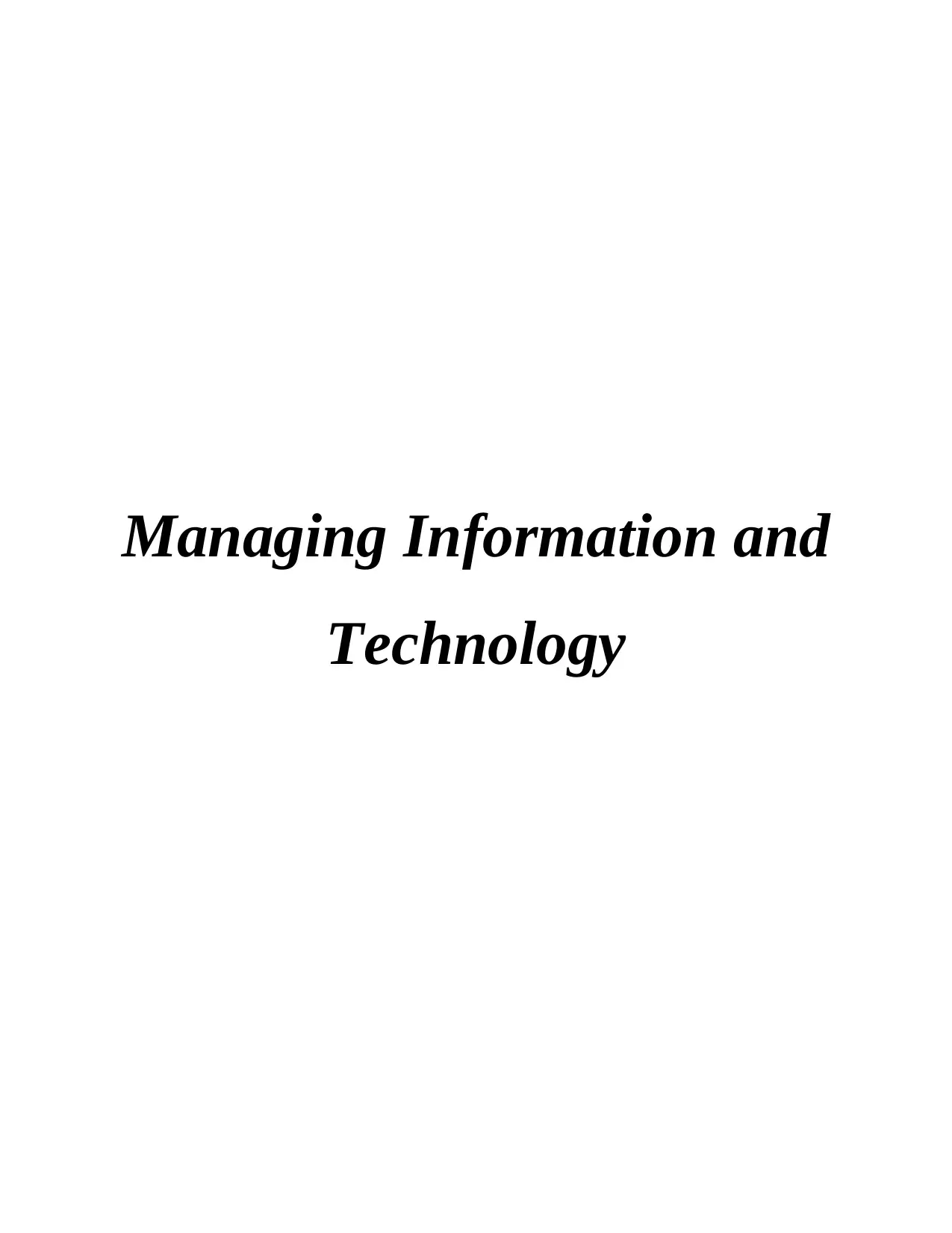
Managing Information and
Technology
Technology
Paraphrase This Document
Need a fresh take? Get an instant paraphrase of this document with our AI Paraphraser
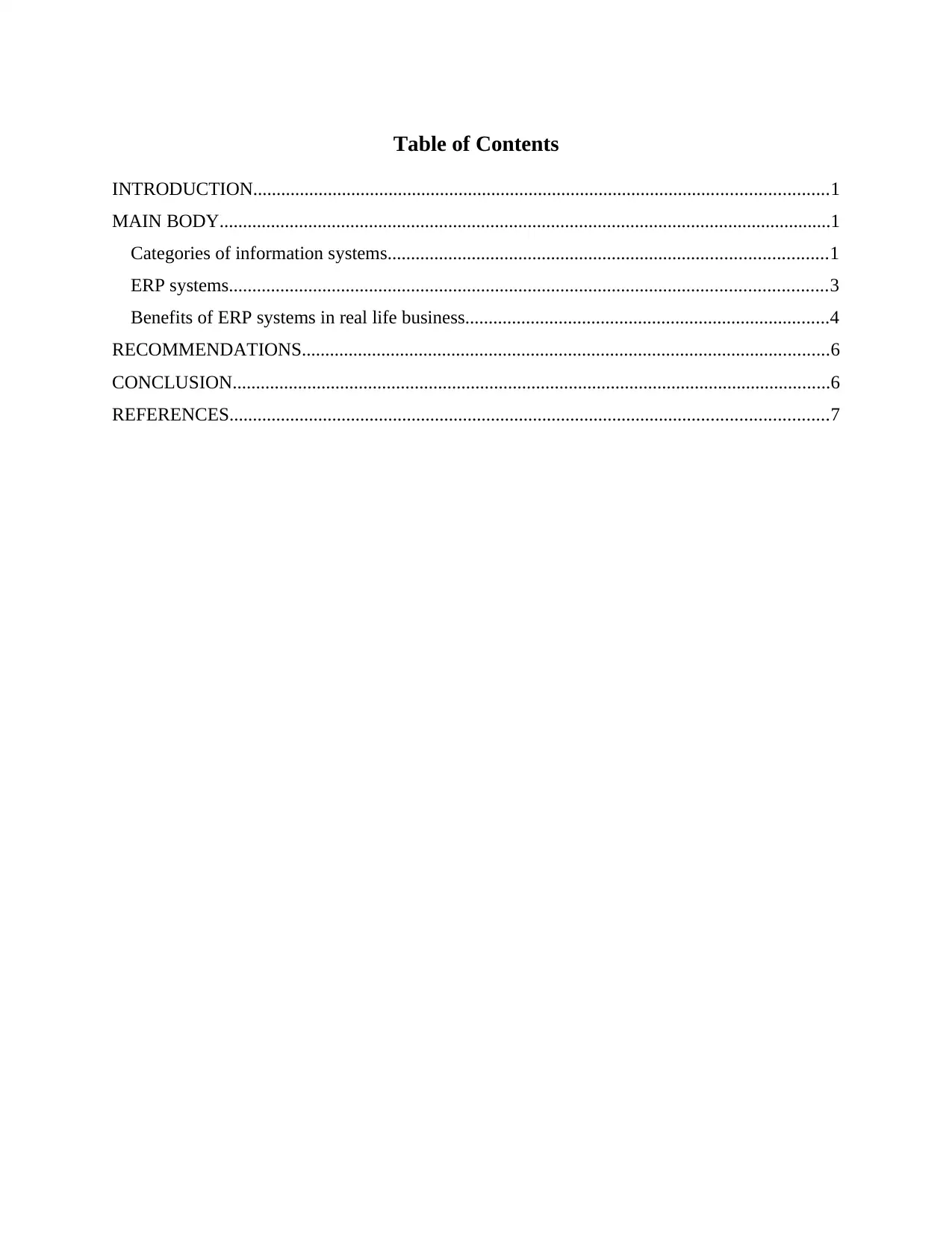
Table of Contents
INTRODUCTION...........................................................................................................................1
MAIN BODY...................................................................................................................................1
Categories of information systems..............................................................................................1
ERP systems................................................................................................................................3
Benefits of ERP systems in real life business..............................................................................4
RECOMMENDATIONS.................................................................................................................6
CONCLUSION................................................................................................................................6
REFERENCES................................................................................................................................7
INTRODUCTION...........................................................................................................................1
MAIN BODY...................................................................................................................................1
Categories of information systems..............................................................................................1
ERP systems................................................................................................................................3
Benefits of ERP systems in real life business..............................................................................4
RECOMMENDATIONS.................................................................................................................6
CONCLUSION................................................................................................................................6
REFERENCES................................................................................................................................7

⊘ This is a preview!⊘
Do you want full access?
Subscribe today to unlock all pages.

Trusted by 1+ million students worldwide
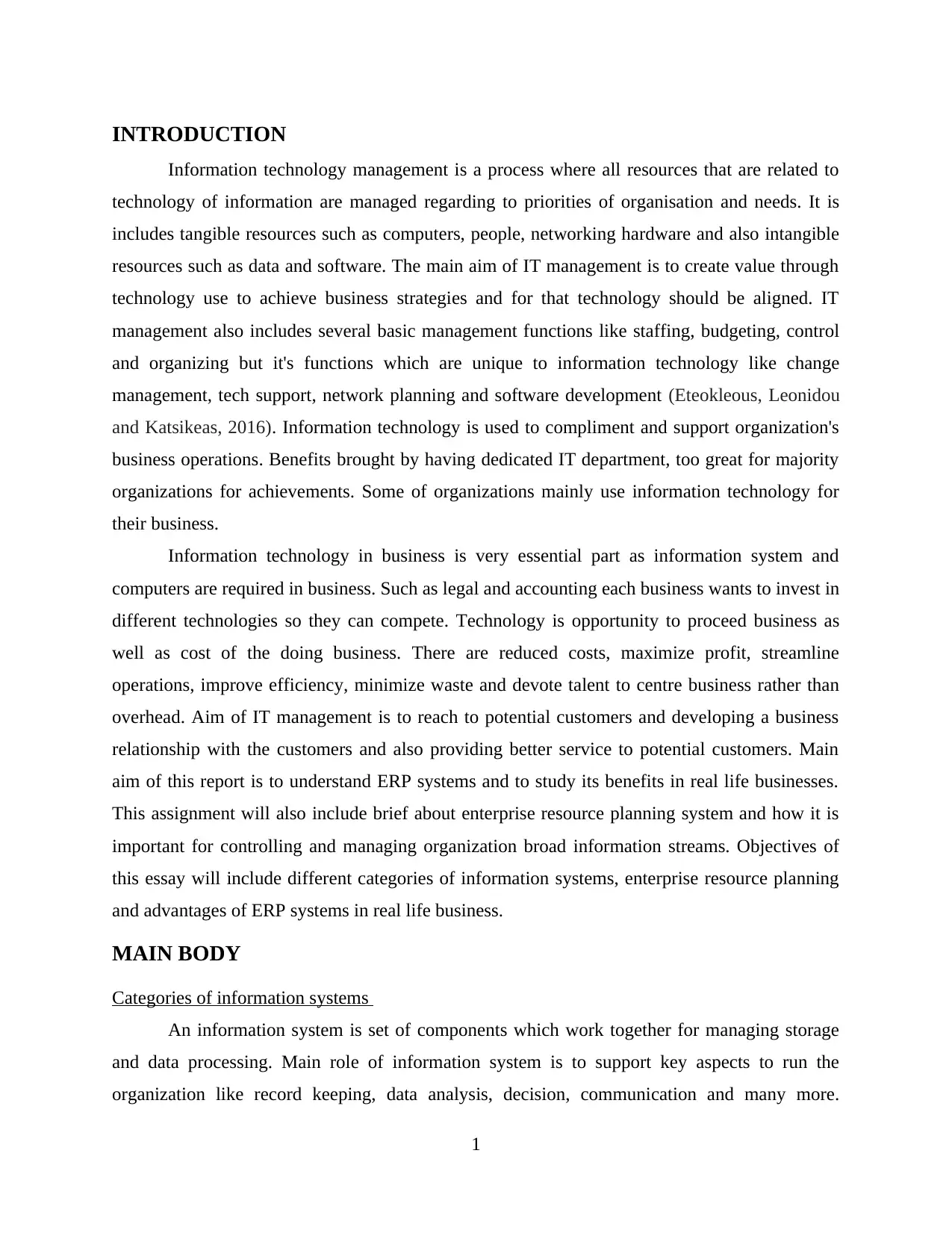
INTRODUCTION
Information technology management is a process where all resources that are related to
technology of information are managed regarding to priorities of organisation and needs. It is
includes tangible resources such as computers, people, networking hardware and also intangible
resources such as data and software. The main aim of IT management is to create value through
technology use to achieve business strategies and for that technology should be aligned. IT
management also includes several basic management functions like staffing, budgeting, control
and organizing but it's functions which are unique to information technology like change
management, tech support, network planning and software development (Eteokleous, Leonidou
and Katsikeas, 2016). Information technology is used to compliment and support organization's
business operations. Benefits brought by having dedicated IT department, too great for majority
organizations for achievements. Some of organizations mainly use information technology for
their business.
Information technology in business is very essential part as information system and
computers are required in business. Such as legal and accounting each business wants to invest in
different technologies so they can compete. Technology is opportunity to proceed business as
well as cost of the doing business. There are reduced costs, maximize profit, streamline
operations, improve efficiency, minimize waste and devote talent to centre business rather than
overhead. Aim of IT management is to reach to potential customers and developing a business
relationship with the customers and also providing better service to potential customers. Main
aim of this report is to understand ERP systems and to study its benefits in real life businesses.
This assignment will also include brief about enterprise resource planning system and how it is
important for controlling and managing organization broad information streams. Objectives of
this essay will include different categories of information systems, enterprise resource planning
and advantages of ERP systems in real life business.
MAIN BODY
Categories of information systems
An information system is set of components which work together for managing storage
and data processing. Main role of information system is to support key aspects to run the
organization like record keeping, data analysis, decision, communication and many more.
1
Information technology management is a process where all resources that are related to
technology of information are managed regarding to priorities of organisation and needs. It is
includes tangible resources such as computers, people, networking hardware and also intangible
resources such as data and software. The main aim of IT management is to create value through
technology use to achieve business strategies and for that technology should be aligned. IT
management also includes several basic management functions like staffing, budgeting, control
and organizing but it's functions which are unique to information technology like change
management, tech support, network planning and software development (Eteokleous, Leonidou
and Katsikeas, 2016). Information technology is used to compliment and support organization's
business operations. Benefits brought by having dedicated IT department, too great for majority
organizations for achievements. Some of organizations mainly use information technology for
their business.
Information technology in business is very essential part as information system and
computers are required in business. Such as legal and accounting each business wants to invest in
different technologies so they can compete. Technology is opportunity to proceed business as
well as cost of the doing business. There are reduced costs, maximize profit, streamline
operations, improve efficiency, minimize waste and devote talent to centre business rather than
overhead. Aim of IT management is to reach to potential customers and developing a business
relationship with the customers and also providing better service to potential customers. Main
aim of this report is to understand ERP systems and to study its benefits in real life businesses.
This assignment will also include brief about enterprise resource planning system and how it is
important for controlling and managing organization broad information streams. Objectives of
this essay will include different categories of information systems, enterprise resource planning
and advantages of ERP systems in real life business.
MAIN BODY
Categories of information systems
An information system is set of components which work together for managing storage
and data processing. Main role of information system is to support key aspects to run the
organization like record keeping, data analysis, decision, communication and many more.
1
Paraphrase This Document
Need a fresh take? Get an instant paraphrase of this document with our AI Paraphraser
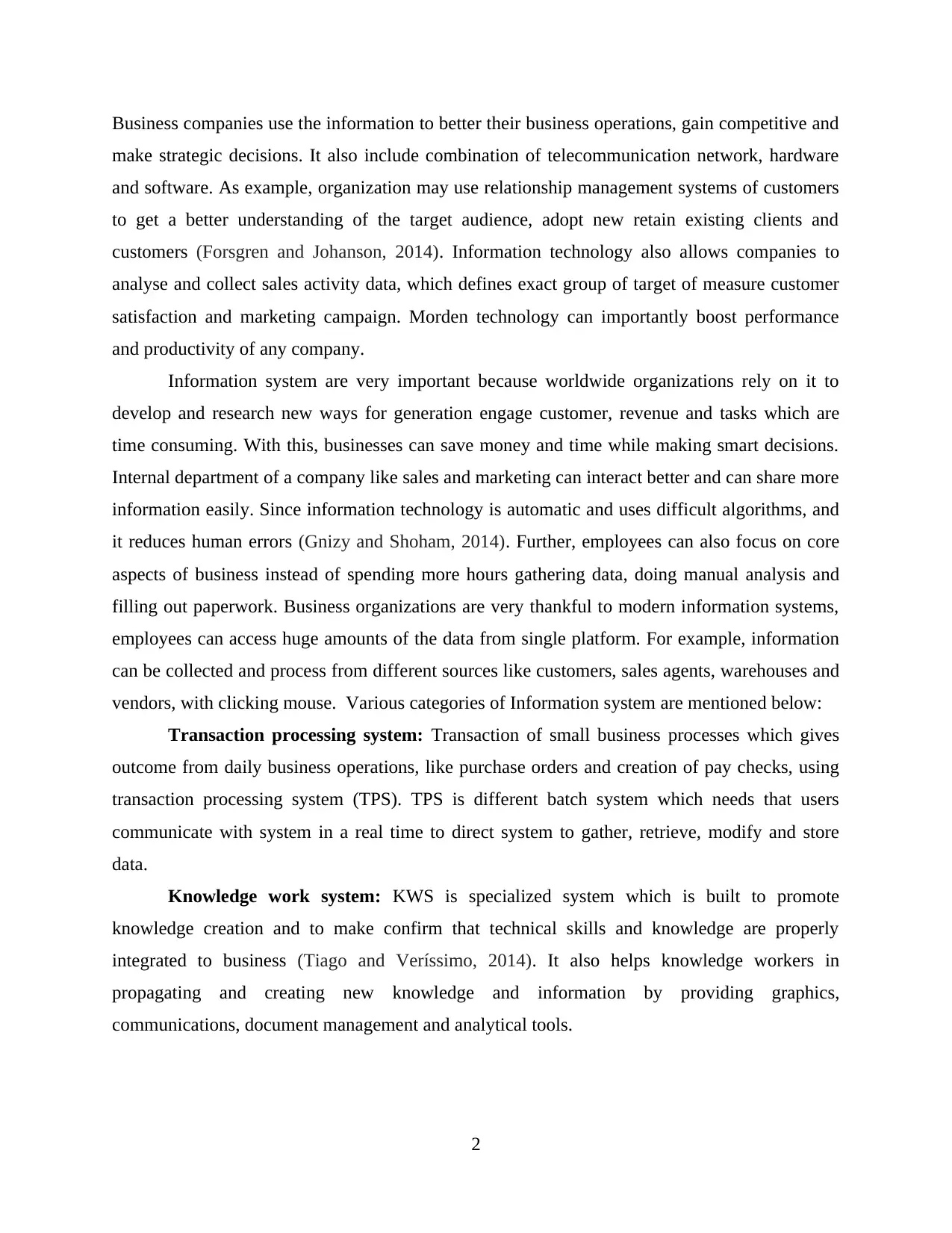
Business companies use the information to better their business operations, gain competitive and
make strategic decisions. It also include combination of telecommunication network, hardware
and software. As example, organization may use relationship management systems of customers
to get a better understanding of the target audience, adopt new retain existing clients and
customers (Forsgren and Johanson, 2014). Information technology also allows companies to
analyse and collect sales activity data, which defines exact group of target of measure customer
satisfaction and marketing campaign. Morden technology can importantly boost performance
and productivity of any company.
Information system are very important because worldwide organizations rely on it to
develop and research new ways for generation engage customer, revenue and tasks which are
time consuming. With this, businesses can save money and time while making smart decisions.
Internal department of a company like sales and marketing can interact better and can share more
information easily. Since information technology is automatic and uses difficult algorithms, and
it reduces human errors (Gnizy and Shoham, 2014). Further, employees can also focus on core
aspects of business instead of spending more hours gathering data, doing manual analysis and
filling out paperwork. Business organizations are very thankful to modern information systems,
employees can access huge amounts of the data from single platform. For example, information
can be collected and process from different sources like customers, sales agents, warehouses and
vendors, with clicking mouse. Various categories of Information system are mentioned below:
Transaction processing system: Transaction of small business processes which gives
outcome from daily business operations, like purchase orders and creation of pay checks, using
transaction processing system (TPS). TPS is different batch system which needs that users
communicate with system in a real time to direct system to gather, retrieve, modify and store
data.
Knowledge work system: KWS is specialized system which is built to promote
knowledge creation and to make confirm that technical skills and knowledge are properly
integrated to business (Tiago and Veríssimo, 2014). It also helps knowledge workers in
propagating and creating new knowledge and information by providing graphics,
communications, document management and analytical tools.
2
make strategic decisions. It also include combination of telecommunication network, hardware
and software. As example, organization may use relationship management systems of customers
to get a better understanding of the target audience, adopt new retain existing clients and
customers (Forsgren and Johanson, 2014). Information technology also allows companies to
analyse and collect sales activity data, which defines exact group of target of measure customer
satisfaction and marketing campaign. Morden technology can importantly boost performance
and productivity of any company.
Information system are very important because worldwide organizations rely on it to
develop and research new ways for generation engage customer, revenue and tasks which are
time consuming. With this, businesses can save money and time while making smart decisions.
Internal department of a company like sales and marketing can interact better and can share more
information easily. Since information technology is automatic and uses difficult algorithms, and
it reduces human errors (Gnizy and Shoham, 2014). Further, employees can also focus on core
aspects of business instead of spending more hours gathering data, doing manual analysis and
filling out paperwork. Business organizations are very thankful to modern information systems,
employees can access huge amounts of the data from single platform. For example, information
can be collected and process from different sources like customers, sales agents, warehouses and
vendors, with clicking mouse. Various categories of Information system are mentioned below:
Transaction processing system: Transaction of small business processes which gives
outcome from daily business operations, like purchase orders and creation of pay checks, using
transaction processing system (TPS). TPS is different batch system which needs that users
communicate with system in a real time to direct system to gather, retrieve, modify and store
data.
Knowledge work system: KWS is specialized system which is built to promote
knowledge creation and to make confirm that technical skills and knowledge are properly
integrated to business (Tiago and Veríssimo, 2014). It also helps knowledge workers in
propagating and creating new knowledge and information by providing graphics,
communications, document management and analytical tools.
2
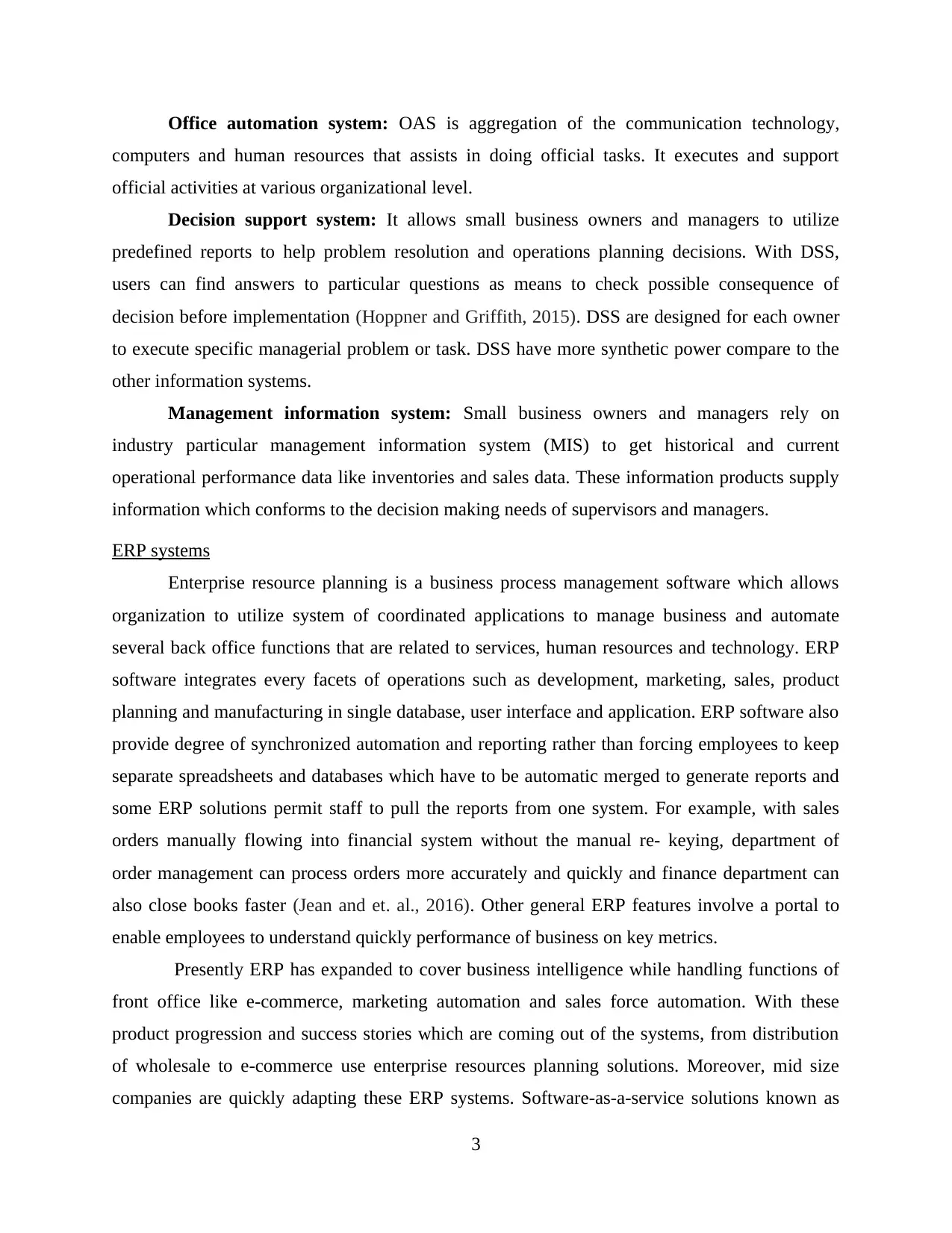
Office automation system: OAS is aggregation of the communication technology,
computers and human resources that assists in doing official tasks. It executes and support
official activities at various organizational level.
Decision support system: It allows small business owners and managers to utilize
predefined reports to help problem resolution and operations planning decisions. With DSS,
users can find answers to particular questions as means to check possible consequence of
decision before implementation (Hoppner and Griffith, 2015). DSS are designed for each owner
to execute specific managerial problem or task. DSS have more synthetic power compare to the
other information systems.
Management information system: Small business owners and managers rely on
industry particular management information system (MIS) to get historical and current
operational performance data like inventories and sales data. These information products supply
information which conforms to the decision making needs of supervisors and managers.
ERP systems
Enterprise resource planning is a business process management software which allows
organization to utilize system of coordinated applications to manage business and automate
several back office functions that are related to services, human resources and technology. ERP
software integrates every facets of operations such as development, marketing, sales, product
planning and manufacturing in single database, user interface and application. ERP software also
provide degree of synchronized automation and reporting rather than forcing employees to keep
separate spreadsheets and databases which have to be automatic merged to generate reports and
some ERP solutions permit staff to pull the reports from one system. For example, with sales
orders manually flowing into financial system without the manual re- keying, department of
order management can process orders more accurately and quickly and finance department can
also close books faster (Jean and et. al., 2016). Other general ERP features involve a portal to
enable employees to understand quickly performance of business on key metrics.
Presently ERP has expanded to cover business intelligence while handling functions of
front office like e-commerce, marketing automation and sales force automation. With these
product progression and success stories which are coming out of the systems, from distribution
of wholesale to e-commerce use enterprise resources planning solutions. Moreover, mid size
companies are quickly adapting these ERP systems. Software-as-a-service solutions known as
3
computers and human resources that assists in doing official tasks. It executes and support
official activities at various organizational level.
Decision support system: It allows small business owners and managers to utilize
predefined reports to help problem resolution and operations planning decisions. With DSS,
users can find answers to particular questions as means to check possible consequence of
decision before implementation (Hoppner and Griffith, 2015). DSS are designed for each owner
to execute specific managerial problem or task. DSS have more synthetic power compare to the
other information systems.
Management information system: Small business owners and managers rely on
industry particular management information system (MIS) to get historical and current
operational performance data like inventories and sales data. These information products supply
information which conforms to the decision making needs of supervisors and managers.
ERP systems
Enterprise resource planning is a business process management software which allows
organization to utilize system of coordinated applications to manage business and automate
several back office functions that are related to services, human resources and technology. ERP
software integrates every facets of operations such as development, marketing, sales, product
planning and manufacturing in single database, user interface and application. ERP software also
provide degree of synchronized automation and reporting rather than forcing employees to keep
separate spreadsheets and databases which have to be automatic merged to generate reports and
some ERP solutions permit staff to pull the reports from one system. For example, with sales
orders manually flowing into financial system without the manual re- keying, department of
order management can process orders more accurately and quickly and finance department can
also close books faster (Jean and et. al., 2016). Other general ERP features involve a portal to
enable employees to understand quickly performance of business on key metrics.
Presently ERP has expanded to cover business intelligence while handling functions of
front office like e-commerce, marketing automation and sales force automation. With these
product progression and success stories which are coming out of the systems, from distribution
of wholesale to e-commerce use enterprise resources planning solutions. Moreover, mid size
companies are quickly adapting these ERP systems. Software-as-a-service solutions known as
3
⊘ This is a preview!⊘
Do you want full access?
Subscribe today to unlock all pages.

Trusted by 1+ million students worldwide
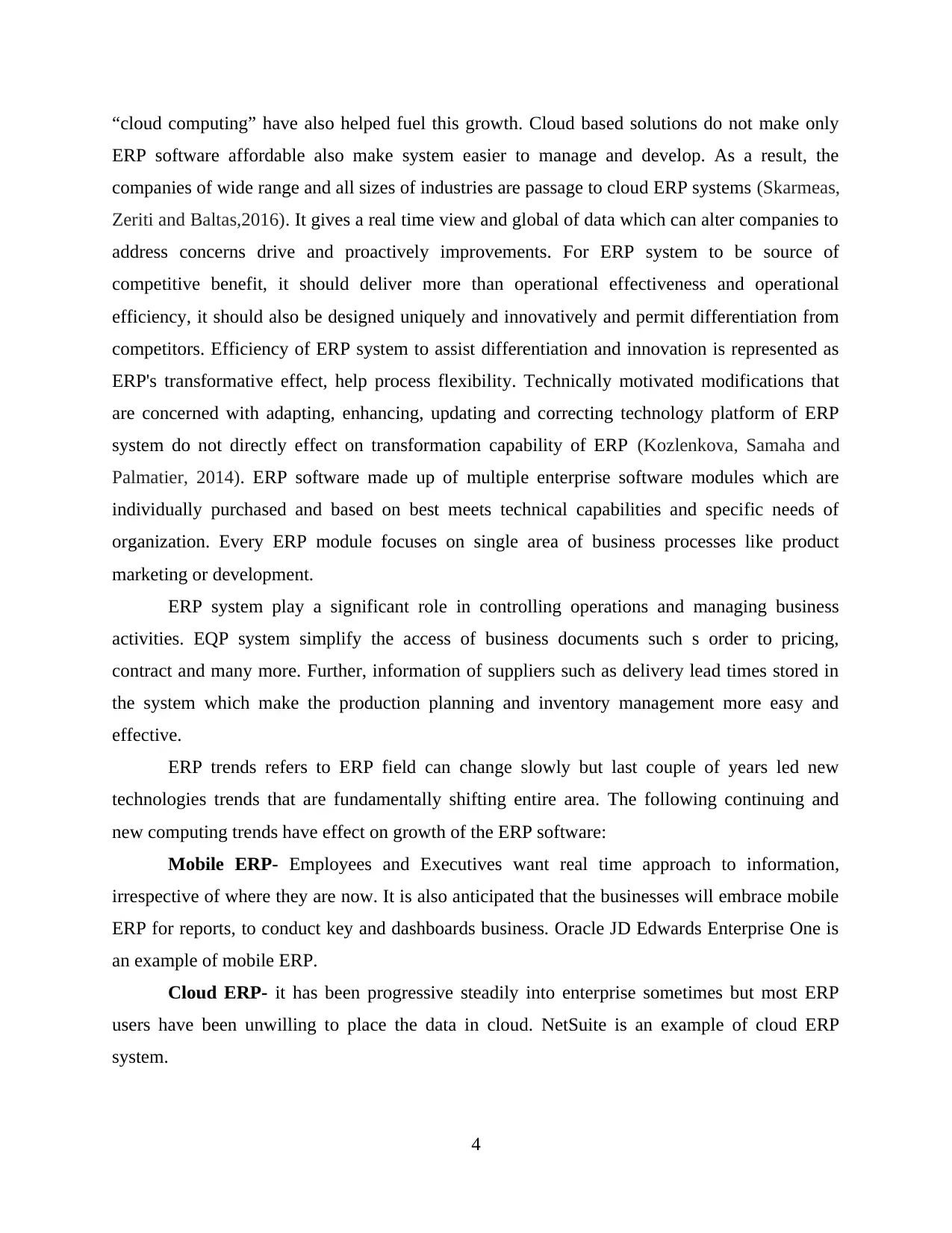
“cloud computing” have also helped fuel this growth. Cloud based solutions do not make only
ERP software affordable also make system easier to manage and develop. As a result, the
companies of wide range and all sizes of industries are passage to cloud ERP systems (Skarmeas,
Zeriti and Baltas,2016). It gives a real time view and global of data which can alter companies to
address concerns drive and proactively improvements. For ERP system to be source of
competitive benefit, it should deliver more than operational effectiveness and operational
efficiency, it should also be designed uniquely and innovatively and permit differentiation from
competitors. Efficiency of ERP system to assist differentiation and innovation is represented as
ERP's transformative effect, help process flexibility. Technically motivated modifications that
are concerned with adapting, enhancing, updating and correcting technology platform of ERP
system do not directly effect on transformation capability of ERP (Kozlenkova, Samaha and
Palmatier, 2014). ERP software made up of multiple enterprise software modules which are
individually purchased and based on best meets technical capabilities and specific needs of
organization. Every ERP module focuses on single area of business processes like product
marketing or development.
ERP system play a significant role in controlling operations and managing business
activities. EQP system simplify the access of business documents such s order to pricing,
contract and many more. Further, information of suppliers such as delivery lead times stored in
the system which make the production planning and inventory management more easy and
effective.
ERP trends refers to ERP field can change slowly but last couple of years led new
technologies trends that are fundamentally shifting entire area. The following continuing and
new computing trends have effect on growth of the ERP software:
Mobile ERP- Employees and Executives want real time approach to information,
irrespective of where they are now. It is also anticipated that the businesses will embrace mobile
ERP for reports, to conduct key and dashboards business. Oracle JD Edwards Enterprise One is
an example of mobile ERP.
Cloud ERP- it has been progressive steadily into enterprise sometimes but most ERP
users have been unwilling to place the data in cloud. NetSuite is an example of cloud ERP
system.
4
ERP software affordable also make system easier to manage and develop. As a result, the
companies of wide range and all sizes of industries are passage to cloud ERP systems (Skarmeas,
Zeriti and Baltas,2016). It gives a real time view and global of data which can alter companies to
address concerns drive and proactively improvements. For ERP system to be source of
competitive benefit, it should deliver more than operational effectiveness and operational
efficiency, it should also be designed uniquely and innovatively and permit differentiation from
competitors. Efficiency of ERP system to assist differentiation and innovation is represented as
ERP's transformative effect, help process flexibility. Technically motivated modifications that
are concerned with adapting, enhancing, updating and correcting technology platform of ERP
system do not directly effect on transformation capability of ERP (Kozlenkova, Samaha and
Palmatier, 2014). ERP software made up of multiple enterprise software modules which are
individually purchased and based on best meets technical capabilities and specific needs of
organization. Every ERP module focuses on single area of business processes like product
marketing or development.
ERP system play a significant role in controlling operations and managing business
activities. EQP system simplify the access of business documents such s order to pricing,
contract and many more. Further, information of suppliers such as delivery lead times stored in
the system which make the production planning and inventory management more easy and
effective.
ERP trends refers to ERP field can change slowly but last couple of years led new
technologies trends that are fundamentally shifting entire area. The following continuing and
new computing trends have effect on growth of the ERP software:
Mobile ERP- Employees and Executives want real time approach to information,
irrespective of where they are now. It is also anticipated that the businesses will embrace mobile
ERP for reports, to conduct key and dashboards business. Oracle JD Edwards Enterprise One is
an example of mobile ERP.
Cloud ERP- it has been progressive steadily into enterprise sometimes but most ERP
users have been unwilling to place the data in cloud. NetSuite is an example of cloud ERP
system.
4
Paraphrase This Document
Need a fresh take? Get an instant paraphrase of this document with our AI Paraphraser
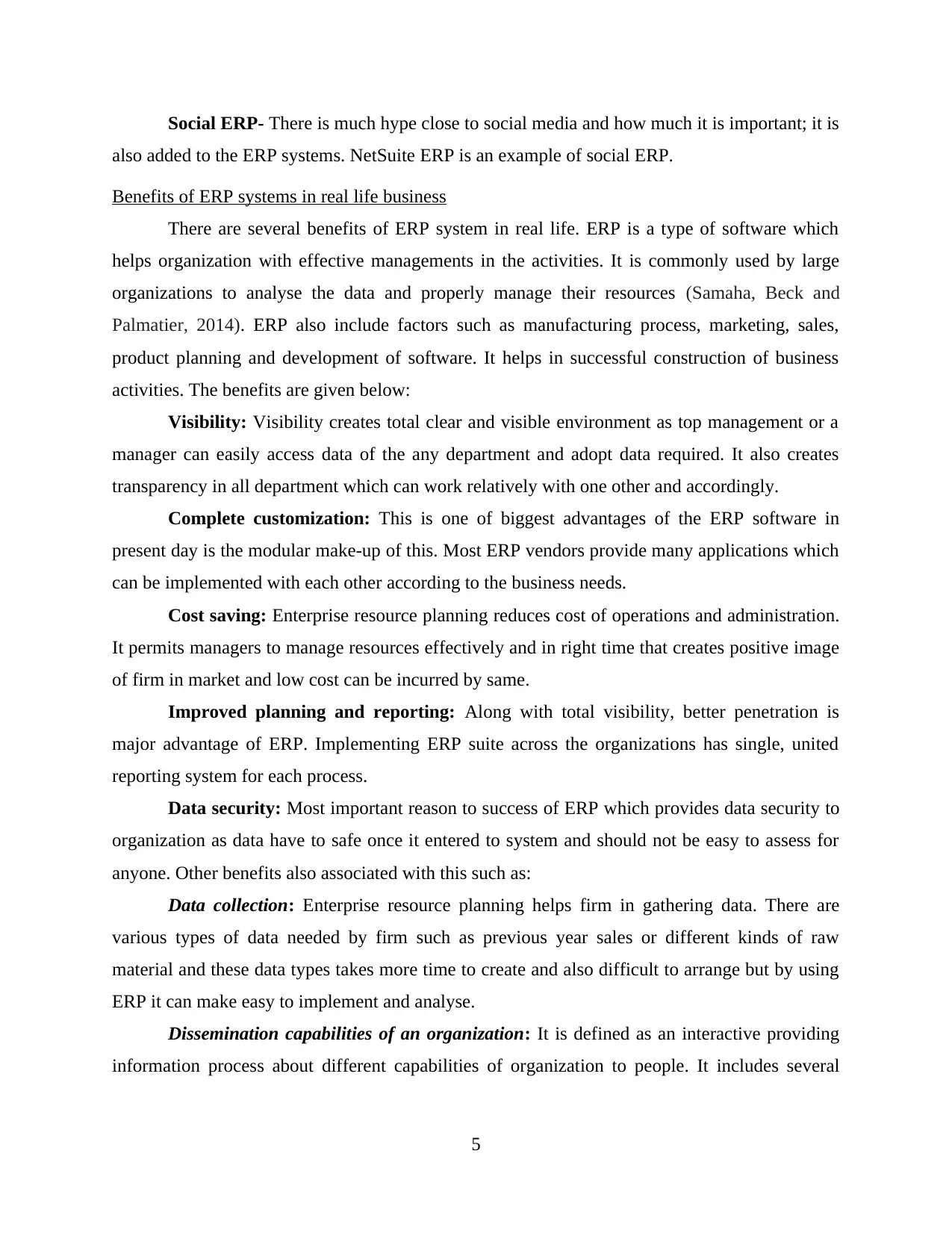
Social ERP- There is much hype close to social media and how much it is important; it is
also added to the ERP systems. NetSuite ERP is an example of social ERP.
Benefits of ERP systems in real life business
There are several benefits of ERP system in real life. ERP is a type of software which
helps organization with effective managements in the activities. It is commonly used by large
organizations to analyse the data and properly manage their resources (Samaha, Beck and
Palmatier, 2014). ERP also include factors such as manufacturing process, marketing, sales,
product planning and development of software. It helps in successful construction of business
activities. The benefits are given below:
Visibility: Visibility creates total clear and visible environment as top management or a
manager can easily access data of the any department and adopt data required. It also creates
transparency in all department which can work relatively with one other and accordingly.
Complete customization: This is one of biggest advantages of the ERP software in
present day is the modular make-up of this. Most ERP vendors provide many applications which
can be implemented with each other according to the business needs.
Cost saving: Enterprise resource planning reduces cost of operations and administration.
It permits managers to manage resources effectively and in right time that creates positive image
of firm in market and low cost can be incurred by same.
Improved planning and reporting: Along with total visibility, better penetration is
major advantage of ERP. Implementing ERP suite across the organizations has single, united
reporting system for each process.
Data security: Most important reason to success of ERP which provides data security to
organization as data have to safe once it entered to system and should not be easy to assess for
anyone. Other benefits also associated with this such as:
Data collection: Enterprise resource planning helps firm in gathering data. There are
various types of data needed by firm such as previous year sales or different kinds of raw
material and these data types takes more time to create and also difficult to arrange but by using
ERP it can make easy to implement and analyse.
Dissemination capabilities of an organization: It is defined as an interactive providing
information process about different capabilities of organization to people. It includes several
5
also added to the ERP systems. NetSuite ERP is an example of social ERP.
Benefits of ERP systems in real life business
There are several benefits of ERP system in real life. ERP is a type of software which
helps organization with effective managements in the activities. It is commonly used by large
organizations to analyse the data and properly manage their resources (Samaha, Beck and
Palmatier, 2014). ERP also include factors such as manufacturing process, marketing, sales,
product planning and development of software. It helps in successful construction of business
activities. The benefits are given below:
Visibility: Visibility creates total clear and visible environment as top management or a
manager can easily access data of the any department and adopt data required. It also creates
transparency in all department which can work relatively with one other and accordingly.
Complete customization: This is one of biggest advantages of the ERP software in
present day is the modular make-up of this. Most ERP vendors provide many applications which
can be implemented with each other according to the business needs.
Cost saving: Enterprise resource planning reduces cost of operations and administration.
It permits managers to manage resources effectively and in right time that creates positive image
of firm in market and low cost can be incurred by same.
Improved planning and reporting: Along with total visibility, better penetration is
major advantage of ERP. Implementing ERP suite across the organizations has single, united
reporting system for each process.
Data security: Most important reason to success of ERP which provides data security to
organization as data have to safe once it entered to system and should not be easy to assess for
anyone. Other benefits also associated with this such as:
Data collection: Enterprise resource planning helps firm in gathering data. There are
various types of data needed by firm such as previous year sales or different kinds of raw
material and these data types takes more time to create and also difficult to arrange but by using
ERP it can make easy to implement and analyse.
Dissemination capabilities of an organization: It is defined as an interactive providing
information process about different capabilities of organization to people. It includes several
5
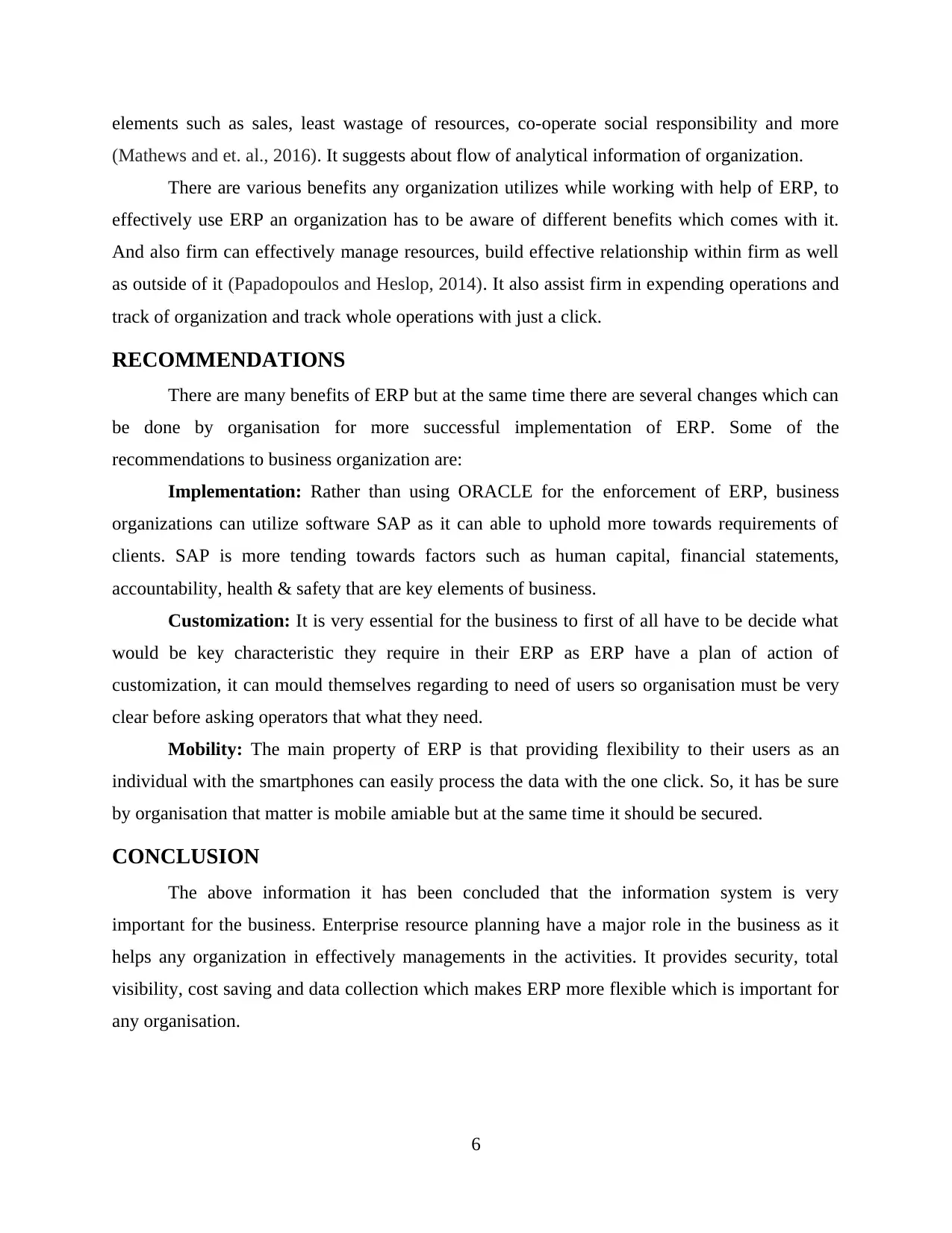
elements such as sales, least wastage of resources, co-operate social responsibility and more
(Mathews and et. al., 2016). It suggests about flow of analytical information of organization.
There are various benefits any organization utilizes while working with help of ERP, to
effectively use ERP an organization has to be aware of different benefits which comes with it.
And also firm can effectively manage resources, build effective relationship within firm as well
as outside of it (Papadopoulos and Heslop, 2014). It also assist firm in expending operations and
track of organization and track whole operations with just a click.
RECOMMENDATIONS
There are many benefits of ERP but at the same time there are several changes which can
be done by organisation for more successful implementation of ERP. Some of the
recommendations to business organization are:
Implementation: Rather than using ORACLE for the enforcement of ERP, business
organizations can utilize software SAP as it can able to uphold more towards requirements of
clients. SAP is more tending towards factors such as human capital, financial statements,
accountability, health & safety that are key elements of business.
Customization: It is very essential for the business to first of all have to be decide what
would be key characteristic they require in their ERP as ERP have a plan of action of
customization, it can mould themselves regarding to need of users so organisation must be very
clear before asking operators that what they need.
Mobility: The main property of ERP is that providing flexibility to their users as an
individual with the smartphones can easily process the data with the one click. So, it has be sure
by organisation that matter is mobile amiable but at the same time it should be secured.
CONCLUSION
The above information it has been concluded that the information system is very
important for the business. Enterprise resource planning have a major role in the business as it
helps any organization in effectively managements in the activities. It provides security, total
visibility, cost saving and data collection which makes ERP more flexible which is important for
any organisation.
6
(Mathews and et. al., 2016). It suggests about flow of analytical information of organization.
There are various benefits any organization utilizes while working with help of ERP, to
effectively use ERP an organization has to be aware of different benefits which comes with it.
And also firm can effectively manage resources, build effective relationship within firm as well
as outside of it (Papadopoulos and Heslop, 2014). It also assist firm in expending operations and
track of organization and track whole operations with just a click.
RECOMMENDATIONS
There are many benefits of ERP but at the same time there are several changes which can
be done by organisation for more successful implementation of ERP. Some of the
recommendations to business organization are:
Implementation: Rather than using ORACLE for the enforcement of ERP, business
organizations can utilize software SAP as it can able to uphold more towards requirements of
clients. SAP is more tending towards factors such as human capital, financial statements,
accountability, health & safety that are key elements of business.
Customization: It is very essential for the business to first of all have to be decide what
would be key characteristic they require in their ERP as ERP have a plan of action of
customization, it can mould themselves regarding to need of users so organisation must be very
clear before asking operators that what they need.
Mobility: The main property of ERP is that providing flexibility to their users as an
individual with the smartphones can easily process the data with the one click. So, it has be sure
by organisation that matter is mobile amiable but at the same time it should be secured.
CONCLUSION
The above information it has been concluded that the information system is very
important for the business. Enterprise resource planning have a major role in the business as it
helps any organization in effectively managements in the activities. It provides security, total
visibility, cost saving and data collection which makes ERP more flexible which is important for
any organisation.
6
⊘ This is a preview!⊘
Do you want full access?
Subscribe today to unlock all pages.

Trusted by 1+ million students worldwide
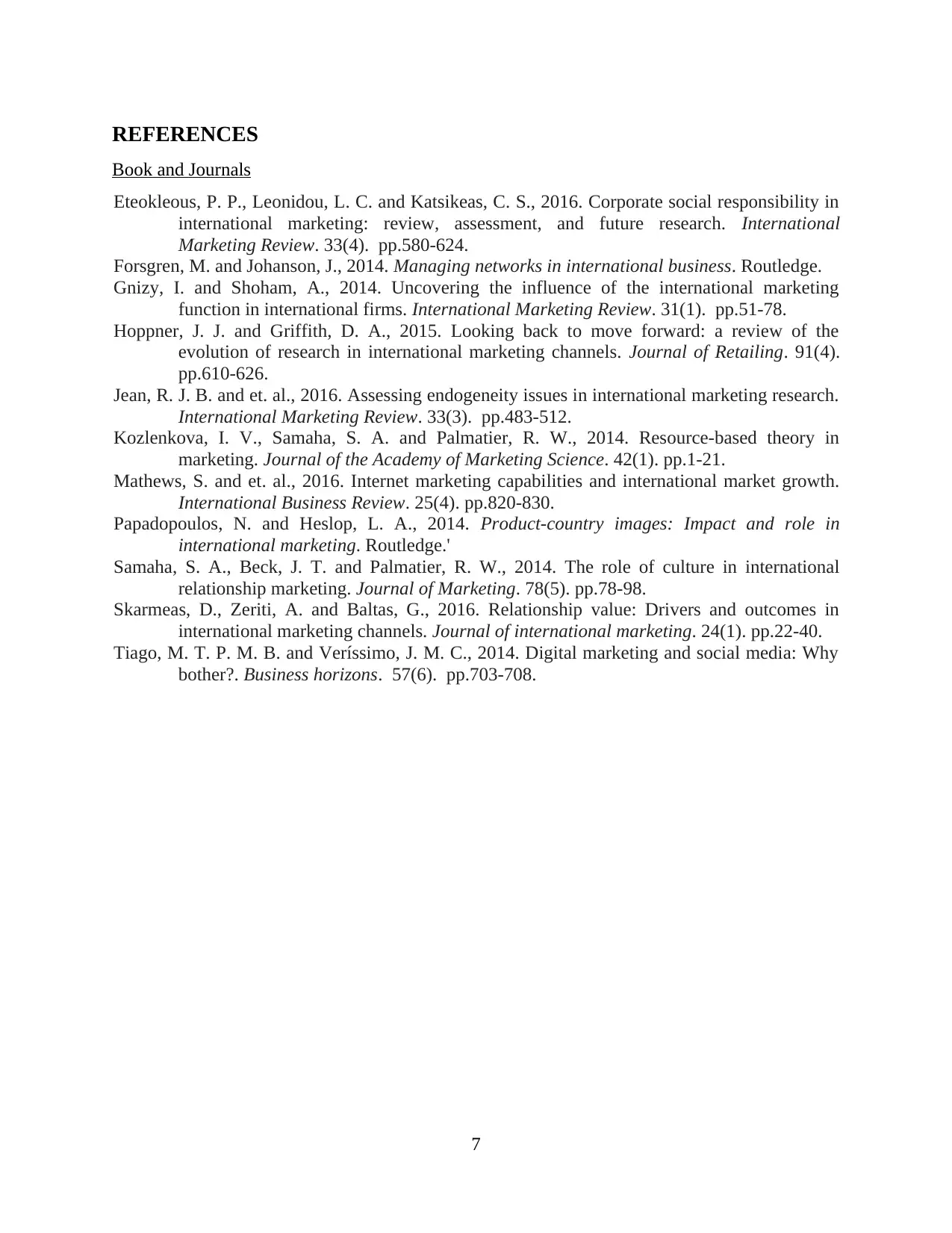
REFERENCES
Book and Journals
Eteokleous, P. P., Leonidou, L. C. and Katsikeas, C. S., 2016. Corporate social responsibility in
international marketing: review, assessment, and future research. International
Marketing Review. 33(4). pp.580-624.
Forsgren, M. and Johanson, J., 2014. Managing networks in international business. Routledge.
Gnizy, I. and Shoham, A., 2014. Uncovering the influence of the international marketing
function in international firms. International Marketing Review. 31(1). pp.51-78.
Hoppner, J. J. and Griffith, D. A., 2015. Looking back to move forward: a review of the
evolution of research in international marketing channels. Journal of Retailing. 91(4).
pp.610-626.
Jean, R. J. B. and et. al., 2016. Assessing endogeneity issues in international marketing research.
International Marketing Review. 33(3). pp.483-512.
Kozlenkova, I. V., Samaha, S. A. and Palmatier, R. W., 2014. Resource-based theory in
marketing. Journal of the Academy of Marketing Science. 42(1). pp.1-21.
Mathews, S. and et. al., 2016. Internet marketing capabilities and international market growth.
International Business Review. 25(4). pp.820-830.
Papadopoulos, N. and Heslop, L. A., 2014. Product-country images: Impact and role in
international marketing. Routledge.'
Samaha, S. A., Beck, J. T. and Palmatier, R. W., 2014. The role of culture in international
relationship marketing. Journal of Marketing. 78(5). pp.78-98.
Skarmeas, D., Zeriti, A. and Baltas, G., 2016. Relationship value: Drivers and outcomes in
international marketing channels. Journal of international marketing. 24(1). pp.22-40.
Tiago, M. T. P. M. B. and Veríssimo, J. M. C., 2014. Digital marketing and social media: Why
bother?. Business horizons. 57(6). pp.703-708.
7
Book and Journals
Eteokleous, P. P., Leonidou, L. C. and Katsikeas, C. S., 2016. Corporate social responsibility in
international marketing: review, assessment, and future research. International
Marketing Review. 33(4). pp.580-624.
Forsgren, M. and Johanson, J., 2014. Managing networks in international business. Routledge.
Gnizy, I. and Shoham, A., 2014. Uncovering the influence of the international marketing
function in international firms. International Marketing Review. 31(1). pp.51-78.
Hoppner, J. J. and Griffith, D. A., 2015. Looking back to move forward: a review of the
evolution of research in international marketing channels. Journal of Retailing. 91(4).
pp.610-626.
Jean, R. J. B. and et. al., 2016. Assessing endogeneity issues in international marketing research.
International Marketing Review. 33(3). pp.483-512.
Kozlenkova, I. V., Samaha, S. A. and Palmatier, R. W., 2014. Resource-based theory in
marketing. Journal of the Academy of Marketing Science. 42(1). pp.1-21.
Mathews, S. and et. al., 2016. Internet marketing capabilities and international market growth.
International Business Review. 25(4). pp.820-830.
Papadopoulos, N. and Heslop, L. A., 2014. Product-country images: Impact and role in
international marketing. Routledge.'
Samaha, S. A., Beck, J. T. and Palmatier, R. W., 2014. The role of culture in international
relationship marketing. Journal of Marketing. 78(5). pp.78-98.
Skarmeas, D., Zeriti, A. and Baltas, G., 2016. Relationship value: Drivers and outcomes in
international marketing channels. Journal of international marketing. 24(1). pp.22-40.
Tiago, M. T. P. M. B. and Veríssimo, J. M. C., 2014. Digital marketing and social media: Why
bother?. Business horizons. 57(6). pp.703-708.
7
1 out of 10
Related Documents
Your All-in-One AI-Powered Toolkit for Academic Success.
+13062052269
info@desklib.com
Available 24*7 on WhatsApp / Email
![[object Object]](/_next/static/media/star-bottom.7253800d.svg)
Unlock your academic potential
Copyright © 2020–2025 A2Z Services. All Rights Reserved. Developed and managed by ZUCOL.





